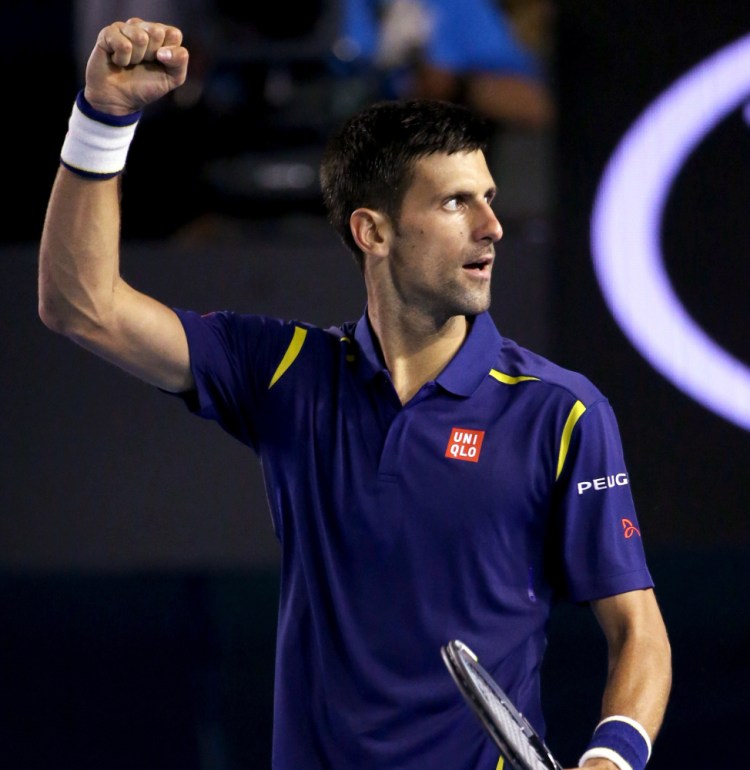MELBOURNE, Australia — Novak Djokovic has a larger than life presence at the Australian Open.
His face smiles at fans from sponsor’s billboards. His voice gives inspirational advice over center-court speakers between matches.
There’s even a new addition to Melbourne Park called “Novak’s World,” where fans can slip on virtual reality goggles and feel as if they’re walking in Djokovic’s shoes – as he stretches in the locker room and then walks out onto the court as the crowd roars.
A few years ago the Australian Open and the other majors could have been called “Roger’s World” – when Roger Federer was No. 1, still dominating men’s tennis and the favorite face of sponsors.
On Thursday, the two player’s worlds collide. Again.
The top-ranked Djokovic will play No. 3 Federer in a blockbuster semifinal match at the Australian Open. It will be the 45th installment in a riveting rivalry that is so equally split that they are tied with 22 wins each.
It’s a rematch of last year’s final at the U.S. Open and Wimbledon, both of which Djokovic won in thrilling nail-biters.
It will be their 15th matchup at a Grand Slam tournament, more than any other pair of men in tennis’ Open era, which dates to 1968. Djokovic and Rafael Nadal have played each other 13 times at majors, Federer and Nadal 11, and John McEnroe and Ivan Lendl 10.
But more than just numbers, it is a tantalizing rematch that holds great importance to both players as they try to cement their place in history.
For Federer, who owns a record 17 Grand Slam titles, it offers a chance to prove that his best is not entirely behind him. He is 34, which means that time really is running out.
“It would mean a lot to me, no doubt about it,” Federer said Tuesday when asked about the significance of winning one more major in the era of Djokovic. “It’s part of the reason why I guess I’m still playing. I feel like I’m competitive at the top. I can beat all the guys on tour.”
That is true, but the problem for Federer has been making it happen in the last round of a major.
Federer hasn’t won a major since Wimbledon in 2012 despite repeatedly coming close. He was runner-up in 2014 at Wimbledon, and in 2015 at Wimbledon and the U.S. Open – beaten all three times by Djokovic.
The 28-year-old Djokovic finished 2015 as the No. 1 player for the fourth time in five years. He won three Grand Slams – the Australian Open, Wimbledon and the U.S. Open – and reached the final at the French Open.
Djokovic is considered the best baseliner in the game.
In Melbourne, Federer has been playing a brilliant brand of attacking tennis, ushering him comfortably through the draw and past No. 6 Tomas Berdych, 7-6 (4), 6-2, 6-4.
“Roger is playing really terrific tennis,” Djokovic said after his 6-3, 6-2, 6-4 quarterfinal win over No. 7 Kei Nishikori. “He’s got great defense, amazing offense. He’s very complete. He puts constant pressure on the opponent. You have to be aware at all times. You’ve got to be tough. You’ve got to be concentrated.”
Angelique Kerber won five consecutive games in the second set and saved five set points to beat two-time champion Victoria Azarenka 6-3, 7-5 in the women’s quarterfinals.
Kerber broke Azarenka’s serve to end the match, hitting a cross-court backhand at the net to beat her for the first time in seven career matches.
Johanna Konta also beat Chinese qualifier Zhang Shuai 6-4, 6-1 to reach the semifinals, becoming the first British woman to advance the last four of a Grand Slam event since 1984.
Send questions/comments to the editors.



Success. Please wait for the page to reload. If the page does not reload within 5 seconds, please refresh the page.
Enter your email and password to access comments.
Hi, to comment on stories you must . This profile is in addition to your subscription and website login.
Already have a commenting profile? .
Invalid username/password.
Please check your email to confirm and complete your registration.
Only subscribers are eligible to post comments. Please subscribe or login first for digital access. Here’s why.
Use the form below to reset your password. When you've submitted your account email, we will send an email with a reset code.